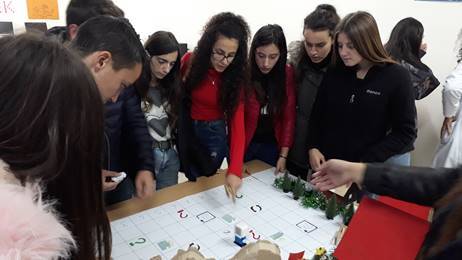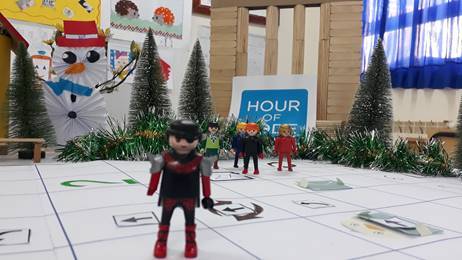Let’s Code in Albania
03/02/20
By Erviola Konomi, Leading Teacher in Albania
This activity was held at High school “Zhani Ciko”, Patos in Albania,
Our mission is to make a difference through our continuous support to educators in their professional development towards effective science teaching and learning. All young people should be educated to think deeply by using ICT so that they have the chance to become the innovators, educators, researchers and leaders who can solve the most pressing challenges facing our world, both today and tomorrow.
This event aimed at engaging children in STEM and coding activities in a playful way because it will be useful for them when starting their careers and looking for a job. Moreover, the activities effectively support young people to develop critical thinking, creativity, digital and collaborative skills, and science capital. The pedagogical method has a strong inclusive potential and fosters
the STEM education and the inclusion of disadvantaged students both inside and outside the classroom.
The goal was also to show to the classical education system that the IT professional world is ready to spend time in order to help the education system in building and/or enhancing their computer programming curriculum.
The Let’s code activity aim was to create awareness for the need for a basic understanding of today’s technology and STEM. It strives for children to be taught the basics of algorithms in
order to safely make use of today’s technology.

Students clubs have organized workshops for new participants and shown them how to make a game or an app with code.
The activity specifically aimed at empowering disadvantaged young people in the acquisition and development of IT, STEM and collaborative competences, as well as problem-solving, self-confidence and creativity through a peer-learning training programme on Coding and use it in STEM projects.
For the introduction to digital applications, we focused on exploring several apps that provide the basic concepts of digital coding, through a playful learning experience. We also gave students insight into a widely used coding language for children by doing some visual coding with Scratch and Minecraft language and showed them how it can be applied to make fun games,
applications and animations. Finally, we introduced our students to the advanced lesson on digital games, robotics and mobile app development.

We created for the students the quality, experience and
the opportunity to be educated by leaders and professionals in the field of
ICT. #ICT #robotic #coding
The main themes that were worked on were: Data manipulation and visualization, Basic programming concepts, Unplugged
activities, Art and creativity, Internet of things and wearable computing, Promoting diversity, etc.

List of activities:
– The students’ information campaign was conducted at our school through brochures on Coding Weeks and Hour of Code and posters for school delivery.
– Initially, the Hour of Code event was linked to the curriculum of the school by designing it as a project in the subject of ICT and in the subject of mathematics (The future in our hand, linking STEM with coding, where students expressed the desire to continue ICT engineer). In the scratch program, we have created an animation where the students express their wishes in
the form of characters, for the professions of the future and argue why. Students at the end of the animation created a quiz with questions and the discussion.
– Unplugged Coding through a game:
We do not really need computers and internet connections
to teach computer thinking to students.
The goal of the activity was to create an algorithm, through the game ” A tourist trip from Edmodo to Albania “
A group of tourists, along with the guide, go to a tourist village. Cicero has prepared fun games to make the exploration more interesting, but only 2 of the tourists agreed to take part, the others continuing their exploration alone.
Cicero explains the rules of the game to the tourists, and the elements used in the game like checkpoints, different orientation signs, information and queries that will give them more information about tourist attractions.

The game conditions are as follows:
The tourist will move a square for each selected card.
If the card “turn right” or “turn left” is selected the tourist will stay in the same spot and return to the directed cards.
If the tourist is positioned in the square that has a question mark, he or his group will select a question from the question box.
If he answers correctly he will continue the game by selecting the letters of the algorithm to move the game to the next level, otherwise, he will lose the guide and return to the starting position.
If they are positioned in the 2x box we have duplication of the last movement of the algorithm.
If positioned in the “return” box, it will rotate 90 ° left or right.

If the tourist arrives at one of the destinations in the “Tourist Village” or “Apollonia” he decides whether to continue the journey in the other attractions, otherwise he will leave the other group with tourists.
Once the game is over, the two tourists or two groups of tourists share their thoughts and impressions on the guide by also presenting the algorithms created and compare them and find the errors in their algorithms.
Students give code instructions to each other. Play the game (In this game you give instructions for moving the robot in squares, then keep track of the robot’s movements, create an algorithm, in the bands, prepare a task, write the commands to complete the task).


